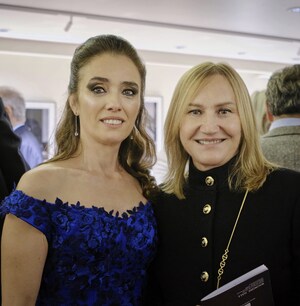New academic catalogue "War and Peace in Russian Porcelain. From the collection of Elena Baturina" presented at the international art historians conference
LONDON, Sept. 26, 2024 /PRNewswire/ -- On September 19th, the catalogue "War and Peace in Russian Porcelain. From the collection of Elena Baturina" was presented at the conference dedicated to the issues of cataloguing art collections. Art historians, critics, experts, museum directors and curators discussed their vision and experience of working with private and museum collections of porcelain and other art objects.
The scientific section of the event featured presentations by Khazar Zeynalov, Deputy Director of the Institute of Architecture and Art of the Azerbaijan National Academy of Sciences; Igor Dukhan, Member of the European Society of Culture and the Academy of Architecture, Professor and Head of the Art Department at the Belarusian State University; Iraida Bott, Deputy Director for Scientific and Educational Work of the Tsarskoye Selo Museum-Reserve; and Pierre-Christian Brochet, curator of the Contemporary Art department at the School of Design HSE. All of the experts unanimously spoke of the grandeur of both the collection and the catalogue, as well as of their importance for art history in general, and the study of porcelain art in particular.
John Bowlt, founder and Director of the Institute of Contemporary Russian Culture at the University of South Carolina and Nicoletta Misler, professor at the L'Orientale, art historian, head of the Center for the Study of Russian Art at L'Orientale prepared a joint address to the conference: "The care, patience, enthusiasm and determination with which Elena Baturina assembled the collection, whether its individual pieces or entire services, are truly admirable. As for the catalogue raisonné: what a magnificent example of scholarship and a monumental effort! Congratulations to all the editors and authors on completing such a pharaonic task - an example of persistent comparative research, a new intellectual perspective."
Natalia Sipovskaya, Director of the Institute of Art Studies and the scientific editor of the publication spoke about the production of "War and Peace in Russian Porcelain" in greater detail. Developing the catalogue took seven years and involved more than 100 specialists. Its 1,500 pages contain unique photographs and texts: the analysis of exceptionally important works from the time of Catherine the Great to the last years of the reign of Nicholas II enabled the authors to truly create an encyclopedia of imperial porcelain. Their findings are illustrated and supported by more than 1,200 graphic sources, 800 archival documents, 300 names of commissioners and initial owners, and about 50 projects of forms and original sketches published for the first time.
Three volumes, entitled in accordance with the items included "GLORY. Russian Imperial Porcelain: Presentation Pieces", "WAR. Items Painted with Military Figures" and "PEACE. Ceremonial Porcelain of Russian Dinnerware" contain detailed descriptions of 1,500 items out of the 2,000 in the collection overall, and cover all significant events in the history of Russian porcelain, also reflecting the historical and artistic context, dates of creation, names of commissioners and recipients of porcelain gifts, history of their existence reconstructed from hundreds of archival sources.
Another achievement of the authors is the scientific apparatus, which contains the study of forms and decorative elements of imperial porcelain - for example, the first complete albums with samples of uniforms of Nicholas' I Russian Guard and Army, an Atlas of Porcelain Flora, an extensive study of Imperial porcelain factory marks are published for the first time.
This became possible thanks to the painstaking collecting work of the owner, the experts concluded. Moreover, the analysis of the collection showed that it contains about 500 unique works that have no representation in any other collections.
According to the experts, the cost of such a collection is very difficult to estimate with any proximity: "Elena Baturina's collection of Russian and European porcelain is not just large-scale and grandiose in its quantitative and qualitative composition, it is surprisingly cohesive. It is this integrity, consistency and structure of the collection that makes it extremely valuable. And I am not talking about the material value, although it is doubtless and impressive - only by rough estimates we are talking about a quarter of a billion dollars - but, first of all, about the historical, artistic, cultural and scientific value," said Natalia Sipovskaya.
English-language copies of the catalogue "War and Peace in Russian Porcelain. From the collection of Elena Baturina" have been submitted to all the major art and art history museums, academies and libraries all over the world. The authors are confident that the publication can facilitate not only new art history discoveries, but overall development of porcelain art.
Photo - https://mma.prnewswire.com/media/2516779/Press_Office_for_Elena_Baturina.jpg


Share this article